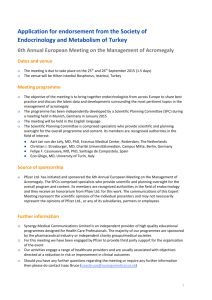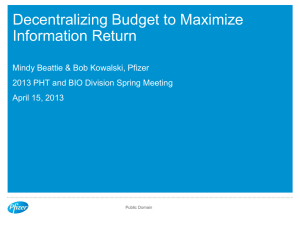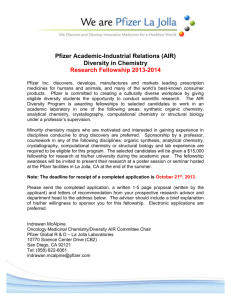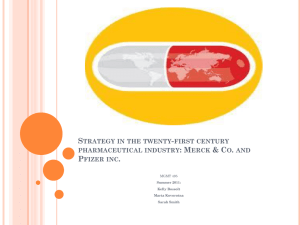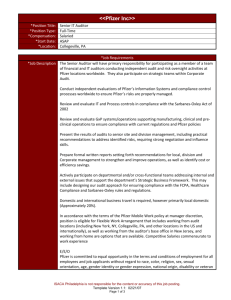File
advertisement
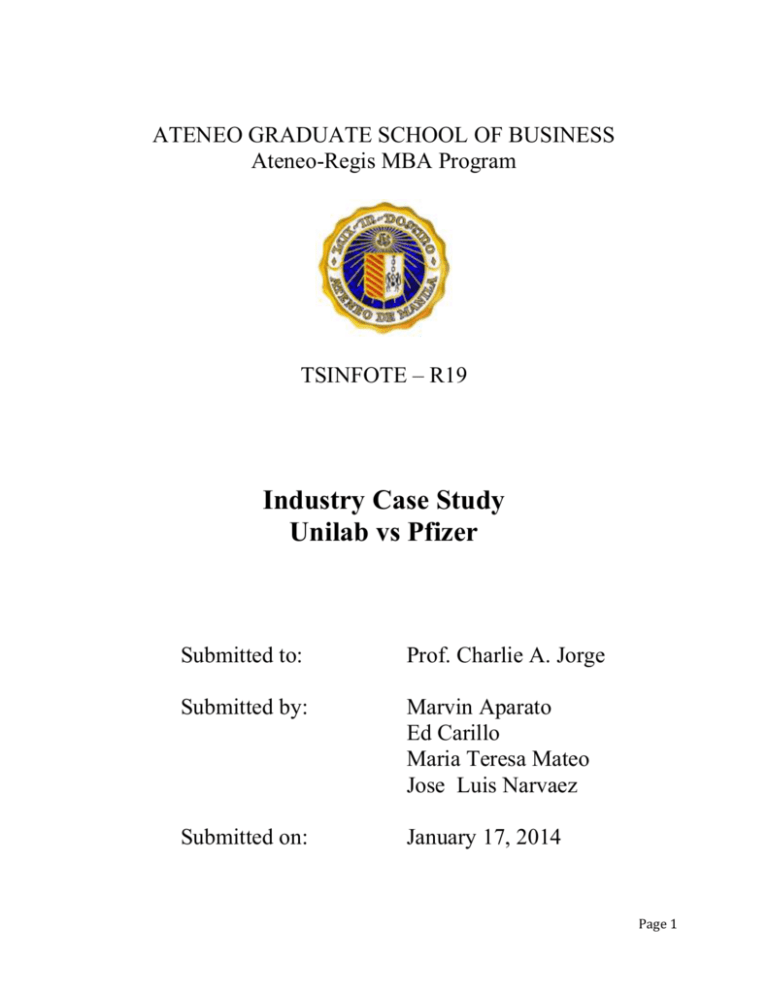
ATENEO GRADUATE SCHOOL OF BUSINESS Ateneo-Regis MBA Program TSINFOTE – R19 Industry Case Study Unilab vs Pfizer Submitted to: Prof. Charlie A. Jorge Submitted by: Marvin Aparato Ed Carillo Maria Teresa Mateo Jose Luis Narvaez Submitted on: January 17, 2014 Page 1 1. Company Backgrounds: 1.1 Unilab - JOE 1.2 Pfizer - ED 2. Best Practices 2.1 Unilab - JOE 2.1.1 Cost and Efficiency Improvements Strategy: Focus on improving efficiency and lowering costs by using the Internet and the World Wide Web as a fast, low-cost way to communicate and interact with customers, suppliers, 2.1.2 Performance Improvement in Business Effectiveness Strategy: Make major improvements in business effectiveness. 2.1.3 Global Market Penetration Strategy: Develop E-business and E-commerce applications optimize interaction with customers and build market share. 2.1.4 Product and Service Transformation Page 2 Strategy: Develop and deploy new Internet-based products and services that strategically reposition it in the marketplace. 2.1 Pfizer - Marvin/Ed 2.1.1 Cost and Efficiency Improvements Pfizer has a Financial Data Warehouse Platform Consolidation (FDWC) project wherein several large financial data warehouses were consolidated onto a single common platform. By building a scalable platform of shared services, the total cost of ownership was reduced for each new application developed. The cost of justification was based on saving money by avoiding the predicted high costs of their current infrastructure in the following areas: - Database technology that scales gracefully to handle data volumes without large cost increases. - Data integration solution framework that would allow sharing of common data across applications - Consolidation of three-application support teams into a single integrated team. A sense of urgency to find innovative ways of coping with enormous complexity was driven by Pfizer’s demand to operate a global biopharmaceutical business with more effective use of information assets amid the anticipated explosion in data volume. At the same time, IT costs were increasing drastically, especially in areas like data warehouse development and operation. It was apparent that strong cost reductions needed to be enforced. To accomplish cost reductions with shared services, business objectives were formulated within GDM and then executed through the FDWC and other projects. Josh Raysman is the lead for Solution Engineering and Project Management for GDM and is “ultimately responsible from the functional deliverables for anything designed and built in our shop”. He summed up the success factors for (Global Data Management) GDM: “We are maximizing our investment in data management solutions by focusing on a long-term total cost of ownership. For long-term success, solutions should have scalability, extensibility, and supportability. In particular, to have supportability means low maintenance costs. A high percentage of our IT budget is spent on application maintenance. We want to get that under control. If we build it right the first time, then we can reduce expenses of care and feeding over time.” Page 3 Strategy: Focus on improving efficiency and lowering costs by using the Internet and the World Wide Web as a fast, low-cost way to communicate and interact with customers, suppliers, 2.2.2 Performance Improvement in Business Effectiveness Information Technology (IT) within Pfizer is named the Business Technology (BT) group, which is composed of two parts: Shared Services (centralized special IT services) and Business Partners (business-facing IT groups aligned to each business unit). Within Shared Services is Global Data Management (GDM), which focused on the Data Management area and is the primary group within Pfizer responsible for the FDWC project. In particular, GDM was “responsible for the design, build and operations of data warehousing, data integration, master data management, including reference data, and business intelligence solutions by providing the common processes, frameworks, and toolsets for effective data stewardship, governance and quality management.” GDM coordinates IT functions (design, build, and operate) from the perspective of four lines of business: � Research and Development, which is the traditional driving force for Pfizer in its competitive marketplace � Finance and Procurement, which is now Financial and Business Operations (a broader area) � Commercial, which are the Sales and Marketing functions � Manufacturing, which produces and distributes medical drugs worldwide for humans and animals � Medical, Diversified, Corporate Functions (such as Legal and Human Resources) Strategy: Make major improvements in business effectiveness. 2.2.3 Global Market Penetration Page 4 Strategy: Develop E-business and E-commerce applications optimize interaction with customers and build market share. Pfizer is committed to adding value to its business relationships. The Pfizer Business to Business section is an e-commerce area designed to maximize relationships with vendors and wholesale distributors already doing business with Pfizer. If you are a wholesale distributor, you can submit orders online through the Pfizer eCommerce Web site. Pre-approved vendors can track invoices through the Pfizer Accounts Payable Web site, and potential IT vendors can introduce themselves to Pfizer using the Pfizer Infrastructure Vendor Registration Web site. The Pfizer Electronic Data Interchange/Electronic Commerce (EDI/EC) Web site for wholesale customers, providing Customer/Client accessibility. It also provides an entry point for transaction processing. (http://www.pfizer.com/b2b/index) Pfizer's OpenForBusiness website provides a safe, convenient, user-friendly online ordering system for its valued customers. Whether ordering large, multi-item orders or small, seldom used items, OpenForBusiness makes it easy to place your orders, view the status of your submitted orders, print an invoice or just browse through Pfizer's catalog of products. Through this site you have access to Pfizer's Pharmaceutical, Animal Health Group, Accounts Payable and Accounts Receivable departments ` to service your needs at any time, day or night (https://ofb.pfizer.com/bjsp/v2/usp/orderEntryV2.do) 2.2.4 Product and Service Transformation Pharmaceutical company Pfizer has implemented a web-based ordering system, B2BE’s e-CatTM, that extends the benefits of e-commerce to customers too small to justify full-blown EDI (electronic data interchange) e-CatTM, from business-to business messaging specialist B2BE, is a customisable web portal that interfaces with EDI so a supplier can give its customers a no-cost entry into the world of ecommerce. With a system that turns online orders into EDI messages, Pfizer is able to expand its base of smaller customers without having to add customer service staff. The two-way system also allows customers to see their order status online, rather than having to contact customer service by phone or fax. Page 5 Strategy: Develop and deploy new Internet-based products and services that strategically reposition it in the marketplace. 3 Recommendations for the 2 companies – need to send and exchange notes via e-mails. – Ed, Marvin, Joe 3.1 Unilab 3.2 Pfizer 4 References: Books: Management Information Systems: Global Edition, 10th edition James A O’Brien and George M. Marakas Websites: http://www.informatica.com/INFA_Resources/wp_bolder_informatica_pfizer_7249.pdf http://www.slideshare.net/priyadarshini.7/about-pfizer-company ACTION ITEMS: 1. Prepare each section – Joe, Ed, Marvin – January 16, 12 noon Page 6 2. Consolidate all materials and check consistency and redundancy – Happy – January 17 – 12 midnight. Page 7
